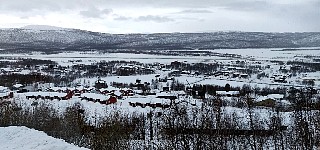
This year's dogsledding trip was unusual. A bit of that was expected. But a lot of it wasn't.
Parts of the trip were fantastic.
For other parts, the mood was gloomier than ever.
No worries, though. The gloominess had nothing to do what happened on the trip.
The initial reason why the trip was unusual had to do with running half-marathons.
Which I don't do.
But Constanze, who likes to do dogsledding and with whom I've travelled on a number of dogsledding trips in the past (It's seven by now - twice in Canada, once in Finland and four times in Sweden), likes running and wanted to take running holidays in 2020 (a running training camp, plus a half-marathon or two in interesting places).
This didn't leave her the time or the budget for a long dog sledding trip this year (though she managed to do a bit of dogsledding around New Year).
So my basic choices were either to join another dogsledding group. Or to have a tour exclusively for myself.
For various reasons (of which some, oddly enough, have something to do with the fact that 2020 ends with a '0'), I decided to indulge and book a tour for me alone.
It's selfish (and expensive), but then again - why not do that once? (It's not going to become a habit. Well, me being selfish and self-indulgent might become (or more likely, already is) a habit, But it's unlikely to be expressed in private dog sledding tours again.)
The hardest part of the trip was the first day.
My flight arrived at Hemavan in the early evening. And as Umnäs, where the dogsledding company is located, is an hour's drive away, it was more convenient to check into a hotel in Hemavan, to be picked up at any convenient time the next day, instead of asking to be picked up at the airport.
There's a nice hotel close to the airport, which I had used in previous years for that purpose.
Unfortunately, that was full booked. So I got a room at another hotel in Hemavan, which wasn't that much farther away.
It seemed.
The downside is that its location is (as they put it) "in the middle of the ski slope"). It's also (unless you actually walk up the ski slope) accessible by a road that makes a very long U-turn before leading back to the hotel.
Which meant that I ended up walking to the hotel with about 30kg of gear (in a shoulder bag and a large duffle bag - nothing designed to be carried on my back or equipped with wheels) for 2.8 kilometers and an altitude difference of 85 meters.
No fun at all.
But, on the other hand, I had covered the physically most demanding part on the first day. So everything after that was easy.
Next day was mainly spent saying "hello" to the dogs in the kennel, trying to remember what their names were and trying to identify the dogs in 'my team'.
And sorting out the gear that I wouldn't be taking on the trip itself, as well as taking some gear that I don't bring or own (like proper dog sledding boots).
My team this year consisted of nine dogs: Lind, Zink, Luna, Tall, Fergus, Valday, Albus, Gran and Harry.
Some of them I already knew. (Especially Gran - that dog has been in front of my sled for the fifth year in a row now.)
I though Fergus was a dog I never had on my team before. But when I looked at the team lists from previous years, it turned out that Fergus had been in 'my team' for the third year in a row now. (Really new to my team was Valday, who had been in Koen's team the previous year and with Kenneth the year before that. Before that, Valday was too young to run. Or, more precisely, hadn't even been born yet during when we were on the dogsledding trip. And, Luna and Albus, who were even younger than Valday, and had only started on tours the previous year, when they were in Constanze's and Koen's teams, respectively.)
This year, the full Potter was on my team. Harry, Luna and Albus are all named after characters from Harry Potter. Which was a fun group to have, as all three of them are playful when not 'on duty' and are fun to have around.
And then it was finally time to do some dogsledding again.
Time to put on the harnesses (and booties where needed), open the gates and get out of the kennel.
Deviating from previous tours, we went on a day trip.
Usually, on the long tours, you start heading out directly to wherever you want to go.
The reason for this is simple: There's always the chance of something unexpected happening, causing some sort of delay. It would be silly to do a day tour first, only to find out later that you're a day short of reaching your destination on the long tour.
But this time, the plan was different, which had a lot to do with what was planned for day two.
So I got to see the local trails for the first time.
Usually, when heading out on a long tour, we went from Umnäs across the lake and headed. towards for Överst-Jugtan. And that is, essentially, the starting place for everywhere else.
But there's also the option to go on the other side of the road and follow the trails there. The opportunity for longer trips are somewhat limited on that side, but it's an area often used for shorter trips.
It's a varied area, with wide trails, forests, lakes, hills and (if you go a bit farther) mountains.
Fun to drive on and, as it turned out, the only segment on this trip I hadn't done before.
Being back on a dog sled was great!
As always, I was a bit worried how much of dogsledding I needed to 'relearn' after a year of not doing it and how much I remembered.
It turned out that it was easier than I thought it would be - getting out of the kennel and onto the proper track involves a 180° curve (taken at some speed as the dogs are eager to go) and crossing a street. So once you're on the track itself, you've already managed the trickier bits.
But the downside of "hey, that works great!" is overconfidence.
So after a couple of kilometers, I had reached into the handle bag of my sled, trying to take something out. And then tried to close the zipper on the handle bag again.
As I was pulling the bag with the zipper, I grabbed one end of the bag with my hand, to hold the bag steady and operate the zipper with the other hand.
Which was, of course, the moment the sled hit a minor bump, I fell off and didn't even manage to grab the handle.
So, on the first day of the trip, an error that should make a first-timer embarrassed.
Not only losing the sled (first rule of dogsledding "Never let go of the sled!"). But also doing that on a straight piece of trail that offered no challenges or obstacles whatsoever.
An embarrassing start to the trip...
At least it helped to avoid overconfidence on the rest of the tour.
Ultimately, the day tour was a bit shorter than planned.
While the trip had started in nice weather, once we were a bit up the hills, the sky turned grey, it got windy and it started to snow.
The weather was still manageable and on a long trip, that wouldn't have stopped us. But we were close to the turning point anyway. It seemed a bit silly to continue for the sake of having lunch (and snacks for the dogs) somewhere in a snowstorm and a longer distance in the snow storm on the way back.
So we skipped the lunch break, turned around and had lunch in comfort at the house instead. (Even with turning around early, we had 32 km and more than two hours of sledding - a nice re-introduction to dog sledding, covering an unexpected variety of terrain and weather conditions.)
And that wasn't even all the dogsledding of the day (but all of the active dogsledding).
They had a couple of puppies the previous year (all named after bicycle manufacturers). They are all a bit too young and inexperienced to go on tours yet, but need some training and experience.
So there was a training run in the afternoon for the puppies.
Catte would do the dogsledding, but I was invited to be a passenger in the sled. (Ostensibly so I could stand on the brakes and secure the sled in case she would need to go and correct or discipline one of the new dogs, but mostly to add some weight to the sled. It's easier to make me sit in the sled than to put six bags of dogfood in it.)
By then the weather had cleared up again and it was a fun run with a somewhat different view (mainly lower) of dogsledding.
Not all the dogs were young ones, of course. The idea is to mix young dogs with experienced ones, so the young ones learn "how it should be done". It's also a nice opportunity for the 'retired' dogs to be 'on the road again'. Some of the dogs are too old now to go on the regular tours. But as 'puppy runs' are comparatively short at the beginning (we went for about an hour and 13 km), that's well in the range they can run and enjoy doing so.
The next day was the day I had been looking forward to (and being worried about) for a whole year.
I had (informally) called it "Ego Day".
Initially, the reason for this was that I wanted to have a nice picture of me dogsledding.
My main vacation has been a 'dogsledding holiday' for more than a decade now.
But I didn't have a really good picture of me doing that.
The best one I had was this from 2012:
The reason for that is simple.
When you are dogsledding, you usually do that in a line. So almost all pictures that you take of other people or that other people take of you will show you directly from the front or from the back.
Like this:
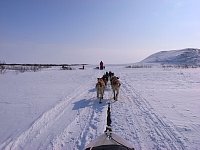 |
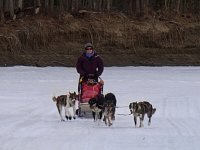 |
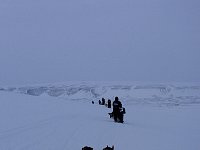 |
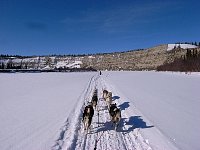 |
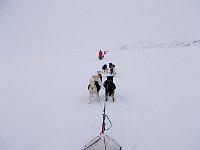 |
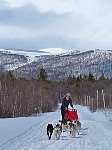 |
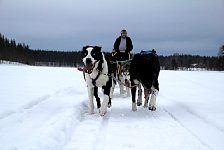 |
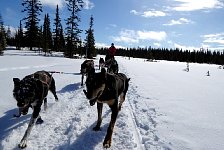 |
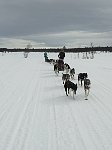 |
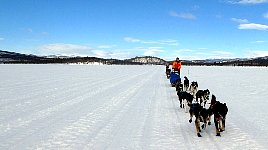 |
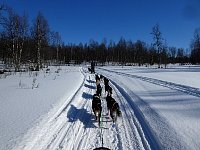 |
| 2009 | 2010 | 2011 | 2012 | 2013 | 2014 | 2015 | 2016 | 2017 | 2018 | 2019 |
Lovely memories, but visually a bit of 'samey'.
Only occasionally there are situations where you can see the teams from another perspective than straight on. But that only happens when the path takes a turn.
So the initial idea was simple: Get a good dogsledding picture of me that's not simply a snapshot from the sled ahead or behind.
As I was the only client on this tour, it seemed a reasonable idea. At least I wouldn't spoil anybody else's vacation to get a good picture of me.
In the initial planning it started reasonably small.
At some point during the tour, we would dogsled on a lake somewhere and have someone, presumably Catte, drive a snowmobile in parallel, stop from time to time and take a couple of snapshots.
Over the course of the year it got a bit more elaborate.
One of the things that happened was that Kenneth and Catte (who own the dogsledding company) knew a professional photographer in Hemavan, named Sam Hedman. And they asked him to take the pictures.
So instead of some snapshots along the way, it turned into a proper photo shoot, with professional gear and drone photography.
The other thing that happened was that I had mentioned that I would like (under very controlled and safe conditions) to run a large dog team once.
I was aware that I'm not good enough to handle a team larger than, let's say, ten dogs on any kind of trail (and later on the trip it was obvious to me that ten dogs are more than I am comfortable with on regular trails. But if we went somewhere on a lake where there were no tricky corners or trees to run into, a larger team might be fine for a day.
The original idea I had was that we might go to Överst-Jugtan as usual. And then I'd take a larger team (let's say 12 dogs) and I'd drive it to the end of the lake and back again, with Kenneth leading on a snowmobile or with a smaller team. (I kind of assumed that we would go on tour, with only the two of us, with 12 dogs in front of Kenneth' sled and 8 dogs in front of mine. So we would, effectively, switch teams for a day.)
My first inkling of what was to come when I had a look at the team list and noticed that in addition to the normal teams there also was an ominous '16-spann'.
Sixteen dogs!
Wow!
And scary!
And utterly fantastic as well!
It took me some time to come up with even an approximate explanation why a team of sixteen dogs is such a big deal.
After all, sixteen dogs won't run noticeably faster than eight dogs.
They share the weight of the sled among more dogs, of course, but over shorter distances, that doesn't have much of an effect.
A large number of dogs is only worthwhile if you have to transport large loads somewhere (if you needed to carry a ton of timber in Klondike back in 1898, you'd better have a large dog team). Large teams are useful in long distance races, where the lighter load per dog and the slight speed difference that makes becomes important in the long run.
But otherwise, large teams are an indulgence.
They don't even make sense on tours where you're out for a couple of days. The extra food you need to carry to feed all those dogs makes up a significant part of the weight they pull. Large dog teams only make sense when you are travelling between places where there's food for them available, so you can use the additional pulling power for other things.
On dog sledding tours, large teams aren't practical at all.
But, on the other hand, a Ferrari isn't a practical car either.
The main reason of driving either is: Why not? (And, of course, ego.)
Time to come back to why a team of 16 dogs is a bit frightening (and, of course, an amazing experience).
The main thing is the lack of control.
Under normal conditions, I can hold a team of eight dogs when standing on the brake of the sled. (Assuming the snow conditions are reasonable and an elk isn't running across the path and the dogs want to give chase.)
With nine dogs, standing on the brake will no longer keep the sled stationary. The sled will slowly creep forward - essentially as if one dog was pulling the sled.
So eight of the sixteen dogs essentially neutralize the brakes. Which means that you still have a full team of eight dogs in front of the sled that you have no real control over.
So having twice the number of dogs isn't like driving a car with a motor with twice the horsepower. It is more like driving your normal car, after you have removed all the brakes from it.
And, of course, no steering. (Though I assume that most dog brains are still better at track following and obstacle recognition than current self-driving cars).
And, similar to dogsledding with 16 dogs, I wouldn't want to attempt that on a regular road.
If I would try to drive a car without brakes and reliable steering, I would prefer to do that in a safe environment, Like a large, flat area with nothing to crash into.
So that's where we headed with the dog sled. At first.
Kenneth had assembled the dog team and driven that out of the kennel, along the track and onto a nearby lake, where I would take over the team for a short bit (and the photo shooting).
The reasons why he could do that (and I could not) are manifold. First of all, he has decades of experience in dogsledding. And, unlike me, not simply a week each year, but the whole season. And he knows what he was doing, while my approach is to stand on the sled and try not to fall off. And even that I failed to do the previous year. And he has steering and braking available, as these are his dogs and they know he will rip their heads off and have them for breakfast, if they don't follow his commands. (He probably won't do that, but the dogs don't know that. A lot of professional dogsledding depends on the dogs not figuring that out.) On the other hand, the dogs know fairly well that, if I give them a command and they ignore it, all I can do is give the command more loudly. Which, ultimately, doesn't impress them much.
In any case, we were at the lake, the weather was great, snow conditions were good, the dog team was ready to go (the dog team is always ready to go). So we switched positions, with Kenneth driving the snowmobile, Sam (the photographer) sitting on the back of it and me on the dog sled.
Time for some great dogsledding pictures!
And of we went!
As expected, the brake didn't do much to stop them or even slow them down.
While sixteen dogs aren't really faster than eight dogs, they are always as fast as eight dogs running. With eight dogs, the brake gives you a certain amount of control regarding the speed you're going. With sixteen dogs, there is only one speed - full speed ahead!
I did hear Kenneth yelling "Go slower!", but I already knew that.
Trouble was that I was already braking as hard as I could.
As can be seen in the pictures, the back of the sled looked more like a snow plow, with all the snow being thrown up from braking hard.
But while going a bit too fast, even with braking (and later I wondered why I did continue doing it - the dogs were almost running at full speed anyway, they wouldn't have been much faster if I'd let go of the brake), all went well and I was beginning to enjoy myself.
There was also a bit of a peninsula jutting out into the lake, which required us to run in a (fairly wide) curve, but that also went without any problems, like me falling off the sled or (something I had been worried about) the dogs deciding to take a trail across the peninsula instead of going around it.
And we already had some great dogsledding pictures!
Time for a stop and cuddling the dogs (telling sixteen dogs how great they are takes some time).
The first stop was surprisingly easy. Kenneth had driven ahead with the snowmobile and stopped it beside the track. And when I got close and said "Whoa!", I got the distinct feeling that the two lead dogs were looking over to Kenneth to check whether they were supposed to follow that command.
So we stopped for a moment while Sam got his drone ready.
I was a bit surprised that some of the dogs took interest in it.
I've seen dogs completely ignoring a helicopter landing and taking off less than 50 meters from them. And even my sister's dog, who is more or less afraid of everything, didn't react at all when I started my small drone in her vicinity last year.
So I had expected the dogs to be completely oblivious to the drone. And while none of the dogs was concerned or worried, about half of them at least looked at the drone when it was close by. At least while standing and waiting. When the dogs are running, very little around them matters.
Then the drone was ready and it was time for the (potentially) most dangerous part of the day. (I thought.)
So far, Kenneth had been fairly close on the snowmobile. Partly to get into good positions for the photographer and partly to be nearby, in case anything went wrong.
As the drone shots were wide angle shots, Kenneth needed to be out of frame for the pictures and to keep some distance. So I was, for a short while, pretty alone with the dogs on the lake.
But the dogs were playing nicely and that shot will definitely make it as a large print onto my office wall. Wow!
After stopping at the end of the lake, I thought that this was it.
We had good sledding pictures with a large team from ground level and from the air.
So I thought we'd were done. Or that Kenneth would turn the team around and I would ride it back along the lake (as there had been some talk about some shots with the mountains in the background and me moving towards the camera, which would work better on the other side of the lake due to location and the direction the sun was shining from.
What was entirely unexpected was that Kenneth sent me and the team towards a path in the forest.
A very wide path, with a lot of distance to any trees at the sides, but still - an actual trail with bends and bumps, ascents and descents.
And a team I had no control over, but which was evidently having fun.
After a while I started to realize that it didn't matter much what I was doing on the back of the sled. So I might as well relax and enjoy the ride, instead of stand there and worry.
Out of habit, I was even pedaling the sled when going uphill, though at that speed, it was mostly a symbolic act.
Photographically, going through the forest wasn't that effective. As the snowmobile was straight ahead of me, some of the pictures looked like the 'usual' dogsledding pictures. In the next image, there are still sixteen dogs in front of my sled, but you could probably do the same picture with six of them.
But as far as dogsledding was concerned, the experience was fantastic.
At some points, the snowmobile was standing around the next corner, getting into position for the next picture. So there were moments where I felt like I was all alone with the sled and a sixteen dog team in the forest.
And while that's purely a fantasy, it was nice to pretend for a short time to be a musher, all alone out there in the wilderness with a large team of powerful dogs propelling the sled forward.
I'm aware that this is nothing else than a child on a fairground carousel pretending to be a cowboy (or, a bit more recent, a kid on TikTok pretending to be Lil Nas X). Although with a bigger budget.
If I would be trying to do this 'for real' I would probably lose the team already during harnessing. By the time I put dog #15 in front of the sled, the other fourteen dogs would have figured out that the sled anchor will not really hold them. And I wouldn't be able to tell them where to go (not that I'd know in the first place), even if I would still be on that sled. Neither would I be reliably able to stop them.
So as much as I could, I tried to make sure that this was as safe as possible.
Or, to use language from commercials: Professional dog-team. Closed course. Do not attempt. Don't try that at home.
(Although the last bit is ridiculous. If you happen to have sixteen dogs, a dog sled and a mountain range at home, you probably already know a lot more about dog sledding than I do. Do whatever you want.)
In any case, on a self-indulgent day like that, it felt appropriate to indulge in a bit of a dog sledding fantasy for a minute.
Then the trail went around some corners, out of the forest and onto the lake again, so we were back at photographs that showed the whole team.
Something I like about the previous picture is that it shows how long a large dog sledding team is. Each segment of the towline (with a dog to each side) is roughly two meters long. A team of sixteen dogs uses eight segments. And the sled is about another two meters long. Which means that you are about eighteen meters away from your lead dog. Which is a long way off.
Time for some more great pictures - big team, sun shining, me looking towards the camera, amazing scenery in the background. Really nice photographs and much better than I had dreamed of when I said a year ago "I would like to have some nice pictures of me doing dogsledding. Can we plan for a photo day?".
Finally we had reached the other side of the lake. And that was it.
One last good-bye to the camera.
And the photo trip with the large team was over for me. I moved back to the snowmobile and Kenneth drove his dogs home.
There it was time to get the dogs out of their harnesses, cuddle them a bit and scoff a bit at Albus who evidently thought that it was his photo shoot (and probably misinterpreting what exposé means...)
One thing that I noticed only later when I re-read the names of the dogs in the '16-spann' list was that Kenneth definitely hadn't been playing it safe. All the dogs on the team were big ones. I had assumed (or would have, if I had thought about it at all) that he would include some of the smaller dogs, like Snövit, Luna, Lind or Neon. But the team the team wasn't just a large team, it was a big team as well.
(Although Neon would be surprised to be listed as a small dog. As far as she knows, she's one of the largest dogs in the yard. She definitely pulls like one and generally acts like one as well.)
In any case - the "Ego Day" was over and it was time to prepare for the main trip.
We were heading out with three sleds. Two of them were driven by Kenneth and me, obviously.
The third one was driven by Irene, who works as a dog handler/trainer at Silent Way.
There were various logistic reasons for her joining the trip.
It's usually better that as many healthy dogs as possible go on the trip. They get restless and frustrated when they get left behind and during the season (which we didn't know yet was about to end early) it's better to keep them in shape. There's also a lot of equipment that needs to be taken along on the tour, regardless of the number of sleds. So it's better to distribute it over three sleds instead of two (even so my sled always has too much stuff in it). And having three people for all the things that need to be done at the huts also would reduce the workload a bit.
Our first day took us, as usual, to Överst-Jugtan.
As on the previous days, the weather started out okay, but got worse in the afternoon.
But nothing that caused problems - only a bit of wind and snow starting halfway along the track.
The it cleared up again and we could have our lunch break in sunshine.
Överst-Jugtan is an easy place to stay with the dogs.
There are dog boxes outside the cabin. So there's no need to get out the stake-out lines, set up wind shielding or lay down straw or hay.
Simply take off the harnesses, clip the dogs to the dog boxes and, later, make and serve them dinner.
As there's also dog food stored there, the first day's running is usually with a light sled as well, as there's no need to put anything but the snacks for the first day onto the sled.
(We did carry snacks for three days on our sleds, but the basic principle still applies - we didn't need to carry any sacks of dry food on the sled with us.)
There was originally the idea to go to Ammarnäs the next day. But the situation there was a bit unclear and there also was a Class 2 storm warning for the afternoon. So we decided to do a short round trip in the morning and be back at Överst-Jugtan before the storm came in.
It would be a bit of a test run for the trip to Ammarnäs the following day, We would initially head down the same trail. But instead of crossing the mountain plateau (where we didn't want to be during a storm) we would turn around and go back.
Once again, the weather started out nicely in the morning.
When we reached the mountain plateau, as predicted, it got noticeably windy, so we quickly turned around.
Back on the lake, it was nice and sunny again - at first.
But the wind was already picking up when we were getting closer to Överst-Jugtan.
Our timing turned out to be pretty good.
We were back at the cabin around 15:20, secured the dogs in their houses, went into the cabin and noticed at 15:54 that the storm was properly upon us.
Nothing dangerous or worrying (even if we still had been out there), but definitely not fun weather to be in.
The next day broke the weather pattern a bit.
Instead of heading out in sunshine, our day started in snowfall.
The skies cleared up a bit during the day, but the weather still remained a mixture of wind, snowfall, sunshine and some ominous clouds.
But the snow conditions on the trail were great, so we were making good progress.
And I also made it past the sign post at the river in Ammarnäs.
There are two tricky bits on the trail to Ammarnäs. On is a parking lot, about a kilometer from the final destination. There is a 90° left turn there, which can be tricky when there are cars parked there. (As, obviously, the needs of passing dog sleds is not something car owners consider when parking their cars.
The other tricky part is going from the trail onto the river in Ammarnäs. It's a tight 90° right turn, going down the river bank, with a signpost right at the corner. As you're going downhill, you want to stand on the brake. But if you brake too much, the dogs will pull the sled right into the signpost and you either crash into it or fall and tip the sled over.
You can also go a bit faster and not hit the sign, but then you're too fast for the corner and will fall as well. It's not easy hitting the 'sweet spot' where you are fast enough to miss the signpost, but not too fast for the corner.
This time I missed that sweet spot and went way too fast around the curve.
So the sled went too wide and drifted sideways through the corner.
It feels like really cool move if it works (and, luckily, it did this time), but it's not something to aim for. If there's any kind of obstacle, like a little snowdrift, the sled runner will hit it sideways and the sled will tip over (while still going to fast, so you're likely to lose it as well). But if there's flat and solid ice on the river and not more than a couple of millimeters of loose snow on the top, you can drift a dog sled on it. Feels fantastic, but it's nothing you can rely on that it'll work.
So as far as 'proper dogsledding' was concerned, that corner was a glorious failure. But fun.
We set up the dog camp at the 'edge of town'.
Kenneth has a depot there, so we could give the dogs ample amounts of straw to lie on.
We also set up the wind shields around the camp.
Our tour last year was the first tour that took them along on the tour (we also were the ones who helped building them). They help the dogs a lot, so the wind shields are now standard equipment on the tours (and another reason why it's better to have three sleds to pack all the stuff).
While it was a long process last year to set up the wind shields (we hadn't worked out yet how to do that efficiently), the routine had now improved (and packing a couple of tent pegs to tie them to, instead of looking for suitable trees, helped a lot). So the dogs were soon comfortable.
Dog duties done, for the moment, we went for our now almost traditional 'after dogs' drink on the veranda of the Guidecenter in Ammarnäs.
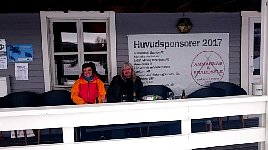 |
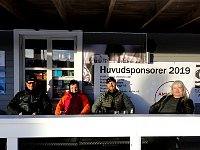 |
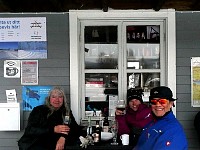 |
| 2017 | 2019 | 2020 |
Which we were allowed to.
The Coronavirus and the related restrictions had recently reached Europe.
When I had been in Rome two weeks earlier, most of Europe was still operating normally, with only the north of Italy under severe restrictions and quarantine measures.
Heading up towards the north of Sweden a couple of days earlier, things were still pretty normal. But over the weekend more and more countries were putting up restrictions for the following week and many companies were requiring their employees to work from home.
The situation in Sweden was a bit uncertain. While Sweden generally relied more on people acting voluntarily on official advice than most other countries (which seemed eager to make breaking their regulations punishable offences), this was partly because Swedes tend to follow sensible regulations voluntarily.
Although, surprisingly, (as it wasn't that much of a sensible thing to do), they had stopped the Finnmarksløpet, the longest European dog sled race (essentially the European equivalent of the Iditarod or the Yukon Quest). The odd thing was that the race was almost finished. They leader was already on section 12 (of 14), so it would have ended a day or two later anyway. And you are rarely more isolated than when being out with your dogs somewhere in the Swedish wilderness.
They could have taken some sensible precautions (end the race outside of town and don't allow spectators, separate the teams after arrival and cancel any award ceremonies) and let the race run its course. But as there was the official stance that there would be no sport events from Monday on, the organizers had decided to honor that decision and stop the race.
And one of the topics in discussion was the closure of tourist related infrastructure.
Norway had already closed all ski slopes to stop winter sport related activities.
Sweden hadn't done that. But it was possible that it might happen there as well.
As a result of this uncertainty, we had revised our route for the trip.
We had planned to stay at some STF huts, but it wasn't certain whether they would stay open. And it would make things quite complicated if we turned up somewhere with 30 dogs after a 40 km run and were told that the place was closed and we had to go elsewhere.
Hence we removed STF huts from our list of destinations.
So we needed to go to places that were preferably privately owned, close to roads (in case we needed to stop the tour for some reason, bring in the trailer and drive back to the kennel) and within a distance that could be covered within a day.
Which had, essentially, left us with Ammarnäs and Bäverholmen.
And even that plan was a bit shaky.
There had been a case of Corona in Ammarnäs, so for a while it wasn't clear what precautions they would take and whether we could even go there. (Besides the upcoming storm, that was the other reason for staying in Överst-Jugtan and having a day tour the previous day, instead of going directly to Ammarnäs).
In the end, it was decided that we could go to Ammarnäs and stay in the guest apartment at the Guidecenter, But the restaurant, like all restaurants in Ammarnäs, would be closed.
But having a drink on the veranda was still ok, so we did that and took a picture to prove it.
Next morning we had nice weather again when we headed out of Ammarnäs.
Soon we were on my nemesis on the other side of town.
Heading into Ammarnäs from Överst-Jugtan, I'm always worried about the parking lot and the turn onto the river.
Heading out of Ammarnäs towards Bäverholmen, I'm always concerned about the road.
It's not really worrying. But it is so annoying.
The first ten kilometers or so out of Ammarnäs, you follow a road.
Not a trail, not a track, but a road.
It is not used as a road in winter, so there's snow on it and it is part of the system of snowmobile trails, but it is a proper road. With more than enough space for dog sleds and room to spare.
And every year I end up with the sled right on the edge of it and being nervous (at the bits where it goes close to the river bank) about falling down.
The reason for that used to be mostly Gran.
Like many dogs, Gran likes to do a lot of dipping on the run (which means he eats snow from the sides of the trail to cool down). Most dogs put their head down and eat a bit of snow from the trail, but Gran prefers the soft snow by the side of it. So Gran like to run close to the side of the trail for that.
But Gran often doesn't simply turn the head and bite into the snow. He steps into the snow beside the trail. Which is not only risky for him, as he might misstep and hurt a leg, but, as he's a wheel dog and close to the sled, it suddenly jerks the sled aside, which is always irritating.
And I tend to end up with other dogs in the team that like the same thing, so while everyone else is nicely lined up in the middle of the road, I'm the one with the sled right at the edge of it.
But not this time - I thought!
When we were on the road, my team was following Kenneth's and Irene's sleds, right in the middle of the road.
I was so impressed (and surprised) by this, that I took out my camera to document that my team was going properly this time.
But that moment of joy only lasted a couple of seconds.
The moment I had the camera out to show how well they were doing, Luna decided that she'd like to go snow dipping now. And pulled the whole team to the side of the road again. (Where the team then stayed for the rest of the road.)
As I had nine dogs on my team, one dog was running without a partner by its side. And that dog was Luna. And after a while, she (unfortunately) noticed that, without a dog to pull her back in line, she could go quite a bit off the center of the trail. Which she quickly started to abuse.
And once Luna had pulled the team over (as the last picture shows, Lind and Zink do their jobs as lead dogs properly), Gran started dipping and running off-road as well.
Nothing problematic - but I had been so impressed by their proper behaviour only a moment earlier. And then that.
The trip to Bäverholmen was fun. There's lots and lots of uphill running, of course, but with nine dogs in front of the sled it's not too bad. And there is a fairly long bit of slanted track, which I had completely forgotten about, but wasn't really a problem. Even when two reindeer crossed the trail a bit ahead of us. (Fortunately the dogs didn't care much or tried to chase them.)
The weather was a bit variable and in parts looking a bit ominous, but for most of the way we had sunshine. A nice day of dogsledding with a lot of variety - from roads to trails, from lakes through forests to bare mountain plateaus. And good snow conditions all the way. Fun.
In Bäverholmen, we set up the dog camp in the place that we had used the previous year.
It's on a small path leading towards the cabins.
The good thing about it is that it already provides good protection from the wind. And with the wind shields set up, the place was turned into a cozy resting place for the dogs. (Especially, as the alternative dog camp was essentially an open field, with no wind protection at all.)
And there was fresh hay available (instead of simply straw), so the dogs liked their 'nests', as they smelled more interesting than 'straw nests'.
The downside is that the path is a bit narrow (and also splits into two at the lower end). That makes the usual chores like dog feeding and excrement removal slightly harder than usual. You need to take more care not to step on any dogs or have them interfering with your work.
Also, the dogs are closer to each other than usual and we had four dogs in various stages of heat, so it took some strategic placement of dogs to avoid problems. (Usually, the dogs are placed on the stake-out lines more or less in the order in which they are running in the teams.)
The other disadvantage of that place becomes obvious when starting from it.
The path is not long enough to start the sleds one behind each other. So all teams have to stand side by side on the path when it's time to go. And it's not wide path either. You have to be very careful not to hit any dogs when your sled passes them (not an easy task, as your own team is eager to go and doesn't want to go slow).
And all the dogs should follow the same path. That's the left path on the second photo above.
I had a short worry the previous year as my team had their 'sleeping quarters' along the smaller right hand path and had lined up that path when we were ready to go.
Once the teams in front went along the other path, my lead dogs reconsidered and followed those teams. So all was fine. But there was a moment when I thought they might run the other way and that would have been a bit harder to manage on a dogsled, as the path goes around a corner. And there's not that much space between the two cabins to go through.
So the dog camp at that place is in a good position for most of the time, but in a terrible position for about three minutes the next morning.
Or, in our case, the morning after that.
The dogs loved it.
Except probably for Denali who started a vendetta against the local vegetation.
When we arrived, we weren't quite sure what we would do the next day.
The options were either to take a rest day. Or to have an easy run with mostly empty sleds up Laisäven, the local river, and back.
In the end, we decided that a proper rest day would be a good thing. So after an extended breakfast, followed soon by an extended lunch break (with some 'taking care of the dogs' in between), we went for an early dinner at the restaurant (which was still open).
Dinner selection still was easy this year, but I will need to think about it next year.
The reason is that there used to be four dishes on the menu (reindeer, elk, fish and hamburger).
When I was there first in 2016, I couldn't decide what to have, so I simply ordered the first one that was listed. And in 2017, for variety, I went for the elk. We didn't pass Bäverholmen in 2018, but when we were back in 2019, I went for the fish (obviously).
So it was hamburger this year.
I had assumed that I would start at the top again when I'd arrive there on a future tour. But they have changed the menu now (and the new list starts with the hamburger), so I will have to make a real decision next time. (I think I'll be able to manage that...)
Next morning it was time to head back.
Initially, the rough idea was to head west and return to Överst-Jugtan in a circle, maybe going via Laislodge and/or Dalovardo and Tärna Lake.
We would probably be able to get into Laislodge and Dalovardo. They are essentially 'emergency huts' with an additional, rentable, room and there would be no other people than us there.
But Tärna Lake was a bit of a risk. It's a larger, 'managed' cabin, so there could be other individuals and groups as well. So they might have decided not to let multiple groups in. Or to close the place down before we arrived. And if that happened, it would be a long way to go anywhere else.
Dalovardo to Tärna Lake is about 30 kilometers. And Laislodge to Tärna Lake is about 65 kilometers. But Tärna Lake to Överst-Jugtan is another 60 kilometers. So if we started out from Laislodge and found that we couldn't stay at Tärna Lake, that would be a very long 125 km day.
And none of the places is anywhere near a road, so we couldn't just have stopped at Dalovardo and evacuated with the dog trailer. (Although we could have done the same as in 2016. Instead of going from Tärna Lake to Överst-Jugtan, we headed towards the nearest street (about 30 kilometers) and loaded the dogs on the trailer there.)
Instead of taking any of those riskier options, we decided to simply head back the way we came.
We knew that we could stay in the guest apartment in Ammarnäs again. And the cabin at Överst-Jugtan as well as the kennel in Umnäs were open to us in any case.
When I was asked, during the initial planning of the trip, whether there was any particular place or trail I wanted to go to, I had answered that it didn't matter that much to me, as I'm mostly there for the dogsledding. And as long as I was dogsledding, I was happy. There are, of course, some places that look more amazing (and are easier or more fun to ride) than others. But, ultimately, it's the dogsledding that matters.
Luckily, it turned out that I really didn't mind going back on the same trails much.
The start from Bäverholmen did have some problems.
The teams were standing side by side (fortunately, none of the teams had decided to head down the alternative path to the right). Kenneth had gone ahead and it was my turn to go next.
But Snövit, one of Irene's lead dogs had been a bit too eager to get to the middle of the path and had gone under my towline. Which meant I couldn't start without running the sled over the dog.
The good thing was that I had noticed that before I pulled my anchor (and the anchor was properly set), so my sled didn't move, even with nine dogs really eager to go. I ran to the front of my sled, and tried to push Snövit back to the other side of it. But Snövit was panicking (with good reason - being run over by a sled is no fun), wiggled out of her harness and took off. Right past Kenneth, who had stopped his team, anchored it and came running back to see why we weren't following.
With Snövit out of the way, I could get going with my sled and stopped behind Kenneth's team. And Irene soon followed. Immediate danger gone, Snövit came back and we could put Irene's team back together. (Although we never figured out how Snövit slipped her collar, which was on the ground somewhere near my lead dogs. On these tours, the lead dogs don't have necklines. So it's not like she could have pulled out of her collar when trying to get away from Yoga.)
After everything was sorted out and the teams were properly lined up in an open area, we could start for real.
Which went surprisingly well.
We didn't know that the properly difficult bit was about to follow.
Instead of heading more or less straight on and driving down onto the river, Kenneth directly made an (almost) 180° turn (ok, let's call it 160°) and then went down to the river in a right/left zig-zag that had a tree on the side.
We had been down that path before (in 2016) and the result was that Constanze and I both fell off our sleds.
This time, it went without any problems. Possibly because we were all still having a lot of adrenalin in our systems, which might have helped reaction speeds a bit.
An additional 'oops' moment came a couple of kilometers later when Kenneth's dogs were a little bit over-eager on a right turn. The path turned right about 20 meters ahead and Kenneth gave the 'gee' command to his dogs. Which, for some reason, they decided to follow immediately, going off-path and heading towards a gap between two trees with a drop (half a meter or so) behind it.
Not the ideal path to follow for Irene and me. But, surprisingly, that went without any problems at all.
And soon we were on the wide snowmobile trail, heading up to the mountain plateau.
Or, my team being the way it is, mostly at the edge of that trail.
(Notice that, once again, Zink and Lind are running properly along the trail, it's Luna and the dogs behind her, who run off-center.)
On last view back towards Bäverholmen...
...and out onto the mountain plateau towards Ammarnäs.
For the only time on this trip, the weather forecast failed us.
So far (and also on previous trips), it had been surprisingly precise, sometimes predicting next day's weather developments correctly to the nearest hour.
This time it was supposed to be all sunny with little wind all the way.
But once up on the mountain plateau, Kenneth pointed to some ominous looking low clouds to the far left of us and mentioned: "That is the weather into which we will be heading soon."
It wasn't anything worrying or dangerous, but it got noticeably colder and windier. And for the only time on the trip, I put up some face protection and put on some fleece gloves over the light gloves I usually wear.
No problem at all, but the weather took us all by surprise.
Once we were back down from the mountain plateau and on the road towards Ammarnäs everything was fine again and, for once, my team properly remained on the road all the way. (Maybe because it was colder and the dogs didn't feel the need to cool down by going snow dipping quite as much.)
We did have a bit of trouble getting to the dog sleeping place, as Kenneth tried to take a different approach than the one that we used to leave the place, but ultimately we all arrived without any damage and set up camp.
As we had already set up the dog camp in the same place three days earlier, it went quickly, even though it started snowing.
We already knew where to put the stake-out lines and the wind shields. And most of the straw was still in place, so we did top it up with some fresh straw and the dogs had nice places to lie on.
As far as I recall, feeding also went quickly, as we didn't give them any dry food, but just fed them with meat snacks. (Part of the reason for this was, as far as I recall, that there was some meat stored there for upcoming tours. But at that point of our tour it was obvious that this tour would be the last long tour of the season. The next tour was supposed to be a tour for a Swiss group, but they weren't able to travel to Sweden. And the same applied to the tour after that. As a result, storing meat in Ammarnäs didn't make sense, so it was better to feed it all to the dogs.)
Then it was back to the Guidecenter and another round of drinks on the veranda (although without a photo this time).
Next morning it was already the penultimate section of the trip - back to Överst-Jugtan.
The first bits (going around the signpost when leaving the river and turning right on the parking lot) were easy this time - they are a lot less troublesome when approached from this direction.
The snowmobile tracks were wide, so it was easy, but slow, going.
My team was usually the slowest of the three teams. Like last year, the dogs didn't seem to like mornings. In the afternoons, I was generally only a little bit slower than Irene's team (but still slower). But in the mornings, Kenneth and Irene spent a lot of time waiting for me.
Although I have to say that my team was only slow compared to the other ones.
Given that there were nine dogs in my team (I had 'only' eight dogs the previous two years) and we didn't need to carry food around (except for the 'lunch break' meat snacks), the overall pace was fast compared with previous years.
After complaining a bit about my dogs running too close to the edge of the track, I need to point out that this is applies solely when running along a straight track. In a situation where the trail goes around a corner, it's completely okay when the dogs run close to the inner side, like below. In that case, it's the musher's responsibility not to run the sled into the snowbank. It's not the dog's fault. (Admittedly, it never is. Even on a straight track it's the musher's responsibility not to run the sled into the snowbank. But there, the dogs are expected to do better.)
In any case, whether on the side of the track or in the middle of it, my sled was still the slowest one.
Kenneth decided to do something about it. He took Voltron from his team and put her right next to Luna. Not only did this add some pulling power to my team, but it also kept Luna from pulling more sideward than forward (and, effectively, negating the pulling power of Zink and Lind in the front row).
So instead of running 12-9-9 teams, we were now running 11-9-10 size dog teams.
As it was a Saturday, a lot of people were out with snowmobiles, probably also because they weren't sure how long they would be allowed to do that and trying to have an outdoor weekend before being required to spend them indoors at home. (Usually we encounter maybe one or two snowmobiles per day on the trail. That day there were about twenty.)
But usually, with one exception, they were aware of the needs of dog sleds and either stopped until we had passed by (when they were heading towards us) or waited until we had stopped on a sufficiently wide part of the trail and waived them to go by (which they did slowly and carefully).
Or they passed in sufficient distance that there weren't any problems.
Running uphill and on the mountain plateau with Voltron on the team was easy and I was able to keep up with the other sleds.
However, when there was a (trivial) right turn, there was a problem.
(I had the camera out at that time, so there are some pictures to show what happened.)
It looks like Voltron didn't pay enough attention and tried to run straight ahead instead of turning, bumping into Luna and the stepping on the towline.
Voltron then bounces up and gets tangled in the line somewhere. (I can't tell whether Voltron steps on the towline, stumbles and bounces up because of Lind and Zink pulling and then gets entangled or whether she bounces up because she is entangled and tries to free herself.) Then she lets out a 'yelp!' and starts to (first) bite Luna's neckline and then a moment later has a go at Luna herself.
I didn't see that Voltron had become entangled - I only noticed that she was aggressive towards Luna. But, to be on the safe side, in case there was some animosity between Luna and Voltron, Kenneth switched the positions of Tall and Voltron, so that Tall and Luna were running side by side and Voltron was running beside Fergus.
After that, the team worked fine and there were no other issues (except for a couple of broken necklines).
The next bit that followed was exciting - going down to the lake Överst-Jugtan.
The trail down there isn't that wide and there are a lot of curves in it.
Usually it's not an issue - if you can control the speed of the sled.
But having ten dogs really makes a difference here.
As I've written earlier, I can usually keep a team of eight dogs where it is.
But a team that is already running is harder to stop. Especially it it's running downhill. The best I can do is regulate the speed a bit. Which is generally sufficient.
But with ten dogs, there is a noticeable difference of the speed range that I have control over. So we went down the track a fair bit faster than I would have done, if I had any choice.
It worked surprisingly well (i.e. without hitting any trees or crashing the sled otherwise) and after a while I decided that there was little that I could really do about it, so I might as well enjoy the ride and do my best not to screw up (as opposed to ride down in terror and do my best not to screw up). The downhill ride was still the same, but at least it now was fun!
And, to my own surprise, I made it down to the lake without any issues. Not even any close calls and 'almost crashes'. It just worked. (Although I think the soft snow at the side of the track helped a lot. While I didn't really run into it, I've touched that a couple of times on the inside of curves and it wasn't noticeable at all. With harder snow, the sled would have bounced back a bit or might have tilted, which would have made the ride more challenging. Potentially too much, though. But everything went well, so it was great running down the hill with ten dogs in front of the sled.)
Once down on the lake the skies turned blue and the sun came out again.
After that excitement an easy ride back to the cabin at Överst-Jugtan.
And with ten dogs in the team and a flat lake to go over, Lind and Zink decided that they had enough of being the last team and decided to speed up and pass Irene's team. (Something that usually goes without any problems, but as three of the dogs in heat were on Irene's team, some dogs in my team did get more interested in checking her team out than in passing it. In the end, we managed to pass without real problems by Irene stopping for a moment and my team pulling ahead. But normally passing works without any issues at all.)
As the weather was fine (and it was the next to last day of the trip and that was almost at an end), I did wear a t-shirt for a bit of the lake crossing, but went back to proper leather jacket before we reached the cabin. (If anything goes wrong when arriving there, it's not a good idea to be pulled behind the sled wearing a t-shirt.)
The arrival at the cabin went without any issues and soon the dogs were in (or at least near) their dog boxes.
Denali had a dog box next to a tree and had somehow decided to continue her one-dog war against vegetation.
At least she stripped the tree of all reachable branches and then had a go on the accessible bits of the bark.
The other dogs had a more relaxed attitude towards the local flora. Even Harry and Luna, who, two years earlier, had a bit of a vendetta against a tree stump in Årrenjarka, where we were stuck for three days and the dogs got bored.
After taking care of the dogs, we sat on the 'porch' behind the cabin, tried to finish the rest of the wine, observed a fox following the dog trail away from us (evidently hoping to find something interesting somewhere) and got a bit gloomy.
Usually, the last night out on the trail is a bit melancholic anyway, as the trip is almost over (and 'almost over' is somehow more of a downer than the actual end of the trip).
But this time it was clear that Kenneth's season was over. Unexpected, when we started out on the trip only a week earlier, it was likely to be his last evening in Överst-Jugtan this season as well. And, taking some time to look at the news on his phone, the world outside seemed to be in a much worse condition than when we left it, with Corona infection and death rates higher than previously expected. And more and more restrictions and closed borders everywhere. I also knew by that time that my flight home from Stockholm had been cancelled, so I had no idea how, when and whether I would be able to go home.
The mood was a bit downcast that afternoon and evening, with this being our last night 'away from it all', before we had to go back and face a changed world, and not changed for the better, the next day.
(Which wasn't quite as melodramatic as the previous sentence makes it sound like, but it reflects pretty much the mood we were in that evening.)
There was also the question: "Do you want to have ten dogs in your team for the last section?"
Tricky question. Ten dogs in a team is a cool size. And I getting down to lake Överst-Jugtan went well, without any tense moments. But there's also a track down to the lake in the middle between Överst-Jugtan and Umnäs, which is narrow and has tight corners.
We decided that I'd probably be fine with ten dogs and that it would make the way up to the plateau a lot easier. I would start with nine dogs for the first bit across the road near Viktoriakyrkan and the bouncy bit of trail that goes parallel to the road, but would add Voltron for the rest of the trip.
Which worked. Barely.
Ten dogs were indeed a lot of help on the uphill parts and on the mountain plateau. For once, I didn't have the slowest team.
But when we came to the narrow downhill trail, the ride turned pretty scary.
I did manage to get to the bottom of the trail without any incidents. But unlike the previous day, were, while not really feeling in control, I felt that everything was going well, this time it felt like running mostly on luck. Not crashing or falling wasn't anything that I actively managed to do. It was at best something I had to hope for.
Imagine a roller coaster ride. Replace the rails with planks. Take a bicycle to the top of the roller coaster and drive down. Yes, there are people that will thrive on the thrill of it all. And, admittedly, it was a thrilling and exhilarating trip.
But it's enough to have it done once.
(Oddly enough, I had driven a team with ten dogs before. And that was on my first dogsledding trip ever. I had nine dogs on the first day (because one of the dogs had been limping a bit, so it was running free instead of pulling) and after that ten dogs for the rest of the trip. But that was on flat sea ice - no trees to hit, no trails, no corners, no climbs or descents. And I didn't know enough about dogsledding to be worried.)
Now we had a small problem right after the difficult bit.
We needed to cross a street, so Kenneth had stopped, checked for cars and crossed. When I tried to cross, I hit the snow drift on the other side and fell off the sled. I managed to keep hold of the sled ("Don't let go the sled!") and was pulled after it, but then I noticed Irene's sled coming at me, with the snow anchor bouncing along its side. At that point I decided that snow anchor are scary and the full text of the rule was "Don't let go the sled, unless you are in danger of getting hurt!" and rolled off into the snowdrift beside the trail.
So it was a bit of a mess for a while, until all sleds were stationary, anchored and re-united with the right mushers again.
By then, we were almost on the lake (a hundred more meters or so), so we stopped there, had some lunch and waited for everyone to calm down a bit.
In the meantime, Voltron was practicing her "there's a camera - I must look cute" skills.
(I have no idea why Voltron ended up next to Albus. I thought that the pairings were Luna/Tall, Fergus/Voltron and Albus/Valday, but that must have changed at some point.)
After the break it was time for the final section home to the kennel.
That part was comparatively easy. While it's another downhill section towards a lake with a road crossing before reaching it, the trail is wide and has more gentle curves.
The main challenge here is that the dogs are really eager to go home. The little 'snow storm' behind the sleds, especially on the last two pictures, shows that we all were standing heavily on our brakes.
But all went smoothly.
Until there suddenly were two dogs standing on the trail.
The thing I noticed at first was a kind of sideward ripple going through the dog teams in front of the sleds ahead of me (I was riding in third position again).
And only when Irene in front of me had passed the obstacle, I noticed the dogs on the trail. They looked vaguely familiar (my dog recognition skills aren't that good anyway and even worse when moving at speed), And the dog team seemed to think so as well.
So when we passed, the dogs in front of the sled tried excitedly to turn towards the dogs that stood there, but we were going too fast, so they couldn't stop, but were kind of deflected from their trajectory. The result was the sideward motion that I had seen in the teams ahead of me.
Only when I was passing the dogs myself, I did see that they were on a leash that led into the trees on the side and Catte was at the other end of it, lying in the snow.
She had been skijoring with two of her dogs towards us and, when she saw us approaching, threw herself into the snow beside the track to keep herself anchored and the dog out of our way.
A bit of a surprise there, but we all got safely down to the road, across it and onto lake Umnässjön.
On the lake, the dogs were eagerly running the final kilometer or so at full speed. With the flat and solid surface beneath their feet, we stopped braking and let them run any way they wanted.
And then all that there's left to do was the final stretch. Off the lake, around the church, across the street and the final curve back into the kennel.
Time for taking off the booties and harnesses, back the sleds away and cuddling some dogs.
And also time for the dogs to act a bit silly.
Next day it was time to thank the dogs for their hard work with something more tangible than cuddles - pig ears!
Completely unrelated to that, I also went to visit Steggur, who is a new horse that had arrived at Silent Way while we were out on our trip.
Seems nice (at least he didn't try to bite or kick me when I petted his nose (or forehead or whatever that part of a horse is called)), but my knowledge of horse temperament is pretty much non-existing. But it's a horse. That I am reasonably sure of.
Here are some statistics about the dogsledding parts, derived from the GPS track data.
| Date | From | To | Start | End | TotalTime | Pause | MovingTime | Distance | Max Speed | Avg. | Mov.Avg. | Start Alt. | Min Alt | Max Alt | Total Asc. | Total Des. | Remark |
| 13.03.2020 | Umnäs | Umnäs | 10:49 | 13:05 | 02:16 | 00:02 | 02:14 | 32.71 | 22.8 | 14.4 | 14.6 | 347.0 | 342.0 | 752.0 | 548.0 | 548.0 | Day tour |
| 13.03.2020 | Umnäs | Umnäs | 16:02 | 16:58 | 00:56 | 00:01 | 00:55 | 13.55 | 21.1 | 14.5 | 14.8 | 364.0 | 352.0 | 403.0 | 155.0 | 155.0 | Puppy run |
| 14.03.2020 | Umnäs | Umnäs | 10:45 | 12:22 | 01:37 | 00:04 | 01:33 | 20.04 | 23.1 | 12.4 | 12.9 | 381.0 | 359.0 | 479.0 | 123.0 | 123.0 | Photo day |
| 15.03.2019 | Umnäs | Överst-Jugtan | 11:19 | 13:56 | 02:37 | 00:05 | 02:32 | 35.33 | 23.8 | 13.5 | 13.9 | 407.0 | 403.0 | 908.0 | 734.0 | 652.0 | |
| 16.03.2019 | Överst-Jugtan | Överst-Jugtan | 11:23 | 14:03 | 02:40 | 00:28 | 02:12 | 31.16 | 21.6 | 11.7 | 14.2 | 496.0 | 483.0 | 776.0 | 644.0 | 644.0 | Day tour |
| 17.03.2019 | Överst-Jugtan | Ammarnäs | 10:40 | 13:22 | 02:42 | 00:04 | 02:38 | 35.21 | 23.8 | 13.0 | 13.4 | 499.0 | 404.0 | 918.0 | 649.0 | 741.0 | |
| 18.03.2019 | Ammarnäs | Bäverholmen | 11:15 | 15:04 | 03:49 | 00:06 | 03:43 | 50.26 | 23.0 | 13.2 | 13.5 | 410.0 | 400.0 | 951.0 | 1109.0 | 1060.0 | |
| 19.03.2019 | Bäverholmen | Bäverholmen | Rest day | ||||||||||||||
| 20.03.2019 | Bäverholmen | Ammarnäs | 11:06 | 14:59 | 03:53 | 00:28 | 03:25 | 50.42 | 25.6 | 13.0 | 14.8 | 473.0 | 398.0 | 954.0 | 1301.0 | 1367.0 | |
| 21.03.2019 | Ammarnäs | Överst-Jugtan | 11:19 | 13:56 | 02:37 | 00:05 | 02:32 | 35.33 | 23.8 | 13.5 | 14.9 | 407.0 | 403.0 | 908.0 | 734.0 | 652.0 | |
| 22.03.2019 | Överst-Jugtan | Umnäs | 11:47 | 15:33 | 03:46 | 00:25 | 03:21 | 47.98 | 24.1 | 12.7 | 14.3 | 498.0 | 339.0 | 794.0 | 966.0 | 1105.0 | |
| Total | 28:11 | 02:11 | 26:00 | 364.44 | 25.6 | 12.9 | 14.0 | 339.0 | 954.0 | 7253.0 | 7450.0 |
As usual, the GPS altitude data is a bit unreliable. Umnäs didn't suddenly rise from 347 meters to 381 meters in two days. And the daily total ascent and descent depends on how much you dampen the altitude curve. But while the information isn't exact, it gives a reasonable approximation of the ups and downs of the trails.
The total distance is also a bit uncertain this time. I was only sitting in the sled during the puppy run. And I don't know how long I have been on the sled during the photo day and how much I have been riding on the snowmobile. Not counting the time in the sled and assuming I did about 10 km on the sled with sixteen dogs in front of me, the total distance I have been driving a sled is more likely to be around 340 km.
And here are the GPS tracks over a satellite image of northern Sweden.
Time to return home.
Somehow.
The way back was, in a way, easier than I thought it would be.
The original plan was to fly to Stockholm, rent a car there, drive around to various places in the area for three days and then fly home.
I already knew that the last part wouldn't happen as planned (the flight had been cancelled), but what about the rest?
Turned out that the first three parts of the plan were still working - fly to Stockholm. rent a car, spend the first night at the Jumbo Stay near the airport.
And the other three parts were not (the hotels in Motala and in Stockholm city were closed and the flight home was cancelled).
Which worked out well for me. The flight from Hemavan to Stockholm would have been very hard to replace with alternatives. But since I wouldn't do much sightseeing in the south of Sweden, I wouldn't go to Motola or Stockholm city in any case.
After a comfortable flight to Stockholm (there were four passengers on that flight, so there was a lot of room in the plane and multiple coffee refills) and some checking of possible options at the SAS service desk in the deserted terminal building (where they were very helpful and tried their best to find ways to get me home, but didn't have anything with enough certainty to justify planning on it).
I went to the car rental company (where I was the only customer as well) and asked about changing my car reservation to a one-way rental to Trelleborg (which did cost extra, but otherwise wasn't any problem) and checked into the Jumbo Stay.
To my surprise, I was greeted there by name. Real VIP treatment.
It turned out that they only had two bookings that hadn't been cancelled. And the other guest had already arrived, so they were reasonably certain who I might be.
My arrival also meant that they could close the reception now and go home.
I spent the night in the 'Black Box' room, which was the last of the 'unusual' rooms
they have and in which I hadn't stayed yet. I had been in the 'Cockpit Suite',
in the 'Engine Room' and the 'Wheelhouse Room', so the 'Black Box' seemed worth a try.
(They do have more rooms, but they are standard rooms with bunk beds.)
When I got up next morning, I was the only one in the hotel airplane.
The other guest had already left and as they had provided a paper bag with my breakfast in it (as they told me the previous day: "Breakfast is... well, whenever you like. It's in the cooler over there, so eat whenever you want to.") there was no need for anyone else to be there in the morning.
So I ate breakfast, made doubly sure that I had taken all my stuff out to the car before I left my room card at the reception (as I needed that to get into the plane and there would nobody be around to let me in until the early afternoon) and drove off.
While there were no reliable flights back home anymore (there were a few that hadn't been cancelled, but they were at least two days or more later, so it was likely that they only hadn't been cancelled yet). And it didn't seem possible to go home by land. (As Denmark had closed its borders, getting home by road or rail via Denmark seemed unlikely. And the other land route via Finland, Russia, Belarus and Poland was even less plausible).
But the ferry from Trelleborg to Rostock was still operating and hotels in Trelleborg were still open.
So I drove the 700 km down to Trelleborg and took the ferry next morning to Rostock.
There I rented another car and drove home.
I hadn't quite expected to leave Sweden that way, but in the end it all worked out reasonably well.